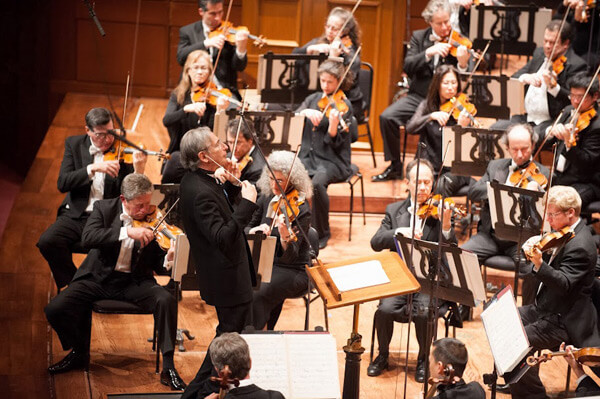

Samuel Carl Adams
Drift and Providence is structured around what Adams refers to in Scott Foglesong’s program note as “three imagined places,” with the two “Drift” movements leading from each “place” to the next. All five movements are performed without pause, although Adams makes wonderful use of silences. “Silences,” Adams says, “can be really loud.” In Drift and Providence silences don’t always mean the same thing, “early in the piece they heighten the tentative or lost quality, and towards the end they serve a heightened sense of intensity.”
The piece began with a rubbed-cowbell drone, which quickly grew into a wash of Ravel-like string figurations swirling around the more clearly defined melodies. In addition to the strings brass and woodwinds, Drift and Providence is scored for an impressive battery of percussion including timpani, vibraphones, sizzle cymbals, bass drum, low toms, brake drums, snare, sandpaper blocks, crotales, tam-tam, large and medium triangles, cowbells, and gong. The percussions were lightly amplified and processed through a laptop run by the composer at the back of the hall. Some of the percussion effects were reminiscent of some of Adams’ other works I’ve heard performed over the past two years including the Tension Studies (No. 1 and No. 2) for guitar and percussion (also with laptop). This intrepid use of texture permeated the entire five movement work, and helped give Adams’ music a unique sound.
I was especially appreciative of the careful use of subtle amplification and processing in combination with “traditional” playing. The blend between live performance in the “classical” style and electronic elements was absolutely seamless, and achieved, I think, what many other attempts at mixes of the two haven’t: a complete unification and blending of sounds both live and electronic. Adams indeed found ways of blending sounds together than reminded me strongly of impressionism, but not in a sappy, pseudo-French way. This music had its own voice, its own sound. It had swirls of sound rushing chaotically around points and lines that emerged from the texture like trees pushing up out of the fog. Clear, easily heard, but never in danger of clashing with the overall soundscape.

Michael Tilson Thomas conducting the SFS in the Opening Concert of the American Mavericks Festival in March 2012.
The program notes—which seem to be based on an interview with Adams—indicated that Drift and Providence was composed in many different locations. This may have added to the piece’s feeling of searching for (and finding) a sort of foundation amongst swirls of sonic fog. While the movement titles are all also real places, (Divisidaro and Embarcadero are both streets in San Francisco, and Providence is the capital of Rhode Island) the movements were not, in fact, inspired by these real places. Instead, Adams was trying to capture internal or imaginary places.
Interestingly, I thought that the Mahler was a good companion piece to Drift and Providence. I commend the San Francisco Symphony for pairing Adams with an established work, thereby putting it on equal footing with the standard repertoire. The Mahler contrasted nicely with the Adams, and principal trumpeter Mark Inouye grabbed our attention with his opening solo. Michael Tilson Thomas took a tempo that was too slow for my tastes, but the audience clearly enjoyed the performance and gave a lengthly standing ovation.
—
Kelsey Walsh is a pianist and currently resides in San Francisco. Follow her on twitter: @kwpianist.
